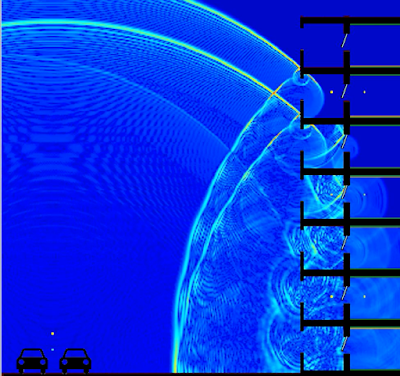A new build range of large residential projects within an Asian capital city (confidential) for the public sector fitted well with our commercial research and development. MACH’s uniqueness in this field facilitated the creation of a new in house software package, implementing Finite-Difference Time Domain (FDTD) mathematics. This software package allows us to model bespoke constructions on a project by project basis, such that solutions are new and innovative.
Sound Insulation of Open Windows and Balconies
Introduction
The use of purge ventilation to naturally ventilate a building, can provide a significant challenge in regards to external noise ingress through the façade and open windows. Typifying the burgeoning requirement for affordable and luxury city centre accommodation, our client wanted bespoke options for a number of confidential, high-rise residential,overseasprojects.
The challenge is providing noise control measures without the use of bulky attenuators, thermal dampers and ugly weather louvers. We pooled our experience in building acousticswith Dr Steve Lo, Senior Lecturer in Sustainable Environmental Engineering at the University of Bath, to investigate the potential of noise mitigation by balcony shaping and other façade design options, in order to screen open windows from external noise sources such as road traffic.
Acoustic Modelling of Noise Ingress and Mitigation
The FDTD software was mainly developed in-house, but also through two MSc projects being supervised by Dr GwenaelGabard and Dr FillipoFazi at the ISVR, funded by MACH Acoustics.
FDTD is similar to commercial Finite Element (FE) modelling but has the advantage that the sound pressure field can be animated over time, allowing the wave propagation to be visualized, measured and assessed. A visual representation is a strong advantage in understanding the reflection and diffraction around walls, windows, balconies and screens.
‘Quiet’ Balconies
Balconies exhibit interesting differences in sound propagation depending on the height and distance from the road.The linked model video belowshows the nature of sound reflections off the balcony façade and soffits, used to assess one of the towers within this development. Adjusting the shape and finishes of these surfaces has shown value in reducing noise ingress into the proposed residential accommodation.
Figure 1: FDTD video of road traffic noise propagating into balconies of a high rise residential building
From the above model, a more detailed view can be presented to show just a single flat/balcony. The images below show a standard single balcony, with a reflector then built from the soffit in the direction of the source (road traffic) to direct sound back away from the balcony.
Figure 2: FDTD model of a single balcony with (bottom) and without (top) a noise mitigating reflective panel


